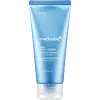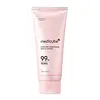What's inside
What's inside
 Key Ingredients
Key Ingredients

 Benefits
Benefits

 Concerns
Concerns

 Ingredients Side-by-side
Ingredients Side-by-side

Water
Skin ConditioningGlycerin
HumectantMyristic Acid
CleansingSorbitol
HumectantPalmitic Acid
EmollientPotassium Hydroxide
BufferingStearic Acid
CleansingLauric Acid
CleansingCetearyl Olivate
Potassium Cocoyl Glycinate
Parfum
MaskingSodium Cocoyl Isethionate
CleansingSorbitan Olivate
EmulsifyingPotassium Cocoate
EmulsifyingCoconut Acid
CleansingButylene Glycol
HumectantSodium Isethionate
CleansingSodium Polyacrylate
AbsorbentPortulaca Oleracea Extract
Skin ConditioningGaultheria Procumbens Leaf Extract
PerfumingDisodium EDTA
Camellia Japonica Flower Extract
EmollientPropanediol
SolventDiisopropyl Adipate
EmollientLecithin
Emollient1,2-Hexanediol
Skin ConditioningSaponaria Officinalis Leaf Extract
AntimicrobialAcrylic Acid/Acrylamidomethyl Propane Sulfonic Acid Copolymer
Dimethylmethoxy Chromanol
AntioxidantGlyceryl Caprylate
EmollientCitric Acid
BufferingPotassium Sorbate
PreservativeSodium Benzoate
MaskingXanthan Gum
EmulsifyingChaenomeles Sinensis Fruit Extract
AntioxidantCitrus Aurantium Dulcis Flower Extract
Skin ConditioningMelissa Officinalis Leaf Extract
Skin ConditioningWater, Glycerin, Myristic Acid, Sorbitol, Palmitic Acid, Potassium Hydroxide, Stearic Acid, Lauric Acid, Cetearyl Olivate, Potassium Cocoyl Glycinate, Parfum, Sodium Cocoyl Isethionate, Sorbitan Olivate, Potassium Cocoate, Coconut Acid, Butylene Glycol, Sodium Isethionate, Sodium Polyacrylate, Portulaca Oleracea Extract, Gaultheria Procumbens Leaf Extract, Disodium EDTA, Camellia Japonica Flower Extract, Propanediol, Diisopropyl Adipate, Lecithin, 1,2-Hexanediol, Saponaria Officinalis Leaf Extract, Acrylic Acid/Acrylamidomethyl Propane Sulfonic Acid Copolymer, Dimethylmethoxy Chromanol, Glyceryl Caprylate, Citric Acid, Potassium Sorbate, Sodium Benzoate, Xanthan Gum, Chaenomeles Sinensis Fruit Extract, Citrus Aurantium Dulcis Flower Extract, Melissa Officinalis Leaf Extract
Water
Skin ConditioningGlycerin
HumectantMyristic Acid
CleansingStearic Acid
CleansingPotassium Hydroxide
BufferingLauric Acid
CleansingNiacinamide
SmoothingGlyceryl Stearate Se
EmulsifyingGlycol Distearate
EmollientPalmitic Acid
EmollientCocamidopropyl Betaine
CleansingPotassium Cocoyl Glycinate
Sodium Polyacrylate
AbsorbentSorbitan Olivate
EmulsifyingSorbitol
HumectantAllantoin
Skin ConditioningPotassium Cocoate
EmulsifyingPolyquaternium-10
Sodium Chloride
MaskingPolyquaternium-7
Butylene Glycol
HumectantCaprylyl Glycol
EmollientAcrylates/C10-30 Alkyl Acrylate Crosspolymer
Emulsion StabilisingTetrasodium EDTA
Anthemis Nobilis Flower Oil
MaskingPyrus Communis Fruit Extract
Skin ConditioningRosa Damascena Flower Water
MaskingPrunus Persica Fruit Extract
AbrasiveThuja Orientalis Extract
AntimicrobialCyanocobalamin
Skin ConditioningJasminum Officinale Flower Water
MaskingCitrus Aurantium Amara Flower Extract
RefreshingRosmarinus Officinalis Leaf Oil
MaskingCucumis Melo Fruit Extract
Skin ConditioningHedera Helix Leaf/Stem Extract
Antimicrobial1,2-Hexanediol
Skin ConditioningPanthenol
Skin ConditioningSodium Dna
Skin ConditioningSodium Benzoate
MaskingCoptis Chinensis Root Extract
AntioxidantEthylhexylglycerin
Skin ConditioningGluconolactone
Skin ConditioningGlutathione
Capryloyl Salicylic Acid
ExfoliatingSalicylic Acid
MaskingCaprylic/Capric Triglyceride
MaskingAdansonia Digitata Seed Oil
EmollientHydrogenated Lecithin
EmulsifyingPentylene Glycol
Skin ConditioningCeramide NP
Skin ConditioningMadecassoside
AntioxidantCorchorus Olitorius Leaf Extract
Skin ConditioningCarum Petroselinum Extract
Skin ConditioningHibiscus Esculentus Fruit Extract
Skin ConditioningDecyl Glucoside
CleansingDimethylsilanol Hyaluronate
HumectantHydrolyzed Hyaluronic Acid
HumectantHydrolyzed Sodium Hyaluronate
Skin ConditioningSodium Hyaluronate
HumectantPotassium Hyaluronate
Skin ConditioningHyaluronic Acid
HumectantCeramide As
Skin ConditioningCeramide Ns
Skin ConditioningHydroxypropyltrimonium Hyaluronate
Sodium Hyaluronate Crosspolymer
HumectantSodium Hyaluronate Dimethylsilanol
HumectantCeramide AP
Skin ConditioningCeramide EOP
Skin ConditioningSodium Acetylated Hyaluronate
HumectantWater, Glycerin, Myristic Acid, Stearic Acid, Potassium Hydroxide, Lauric Acid, Niacinamide, Glyceryl Stearate Se, Glycol Distearate, Palmitic Acid, Cocamidopropyl Betaine, Potassium Cocoyl Glycinate, Sodium Polyacrylate, Sorbitan Olivate, Sorbitol, Allantoin, Potassium Cocoate, Polyquaternium-10, Sodium Chloride, Polyquaternium-7, Butylene Glycol, Caprylyl Glycol, Acrylates/C10-30 Alkyl Acrylate Crosspolymer, Tetrasodium EDTA, Anthemis Nobilis Flower Oil, Pyrus Communis Fruit Extract, Rosa Damascena Flower Water, Prunus Persica Fruit Extract, Thuja Orientalis Extract, Cyanocobalamin, Jasminum Officinale Flower Water, Citrus Aurantium Amara Flower Extract, Rosmarinus Officinalis Leaf Oil, Cucumis Melo Fruit Extract, Hedera Helix Leaf/Stem Extract, 1,2-Hexanediol, Panthenol, Sodium Dna, Sodium Benzoate, Coptis Chinensis Root Extract, Ethylhexylglycerin, Gluconolactone, Glutathione, Capryloyl Salicylic Acid, Salicylic Acid, Caprylic/Capric Triglyceride, Adansonia Digitata Seed Oil, Hydrogenated Lecithin, Pentylene Glycol, Ceramide NP, Madecassoside, Corchorus Olitorius Leaf Extract, Carum Petroselinum Extract, Hibiscus Esculentus Fruit Extract, Decyl Glucoside, Dimethylsilanol Hyaluronate, Hydrolyzed Hyaluronic Acid, Hydrolyzed Sodium Hyaluronate, Sodium Hyaluronate, Potassium Hyaluronate, Hyaluronic Acid, Ceramide As, Ceramide Ns, Hydroxypropyltrimonium Hyaluronate, Sodium Hyaluronate Crosspolymer, Sodium Hyaluronate Dimethylsilanol, Ceramide AP, Ceramide EOP, Sodium Acetylated Hyaluronate
 Reviews
Reviews

Ingredients Explained
These ingredients are found in both products.
Ingredients higher up in an ingredient list are typically present in a larger amount.
1,2-Hexanediol is a synthetic liquid and another multi-functional powerhouse.
It is a:
- Humectant, drawing moisture into the skin
- Emollient, helping to soften skin
- Solvent, dispersing and stabilizing formulas
- Preservative booster, enhancing the antimicrobial activity of other preservatives
Butylene Glycol (or BG) is used within cosmetic products for a few different reasons:
Overall, Butylene Glycol is a safe and well-rounded ingredient that works well with other ingredients.
Though this ingredient works well with most skin types, some people with sensitive skin may experience a reaction such as allergic rashes, closed comedones, or itchiness.
Learn more about Butylene GlycolGlycerin is already naturally found in your skin. It helps moisturize and protect your skin.
A study from 2016 found glycerin to be more effective as a humectant than AHAs and hyaluronic acid.
As a humectant, it helps the skin stay hydrated by pulling moisture to your skin. The low molecular weight of glycerin allows it to pull moisture into the deeper layers of your skin.
Hydrated skin improves your skin barrier; Your skin barrier helps protect against irritants and bacteria.
Glycerin has also been found to have antimicrobial and antiviral properties. Due to these properties, glycerin is often used in wound and burn treatments.
In cosmetics, glycerin is usually derived from plants such as soybean or palm. However, it can also be sourced from animals, such as tallow or animal fat.
This ingredient is organic, colorless, odorless, and non-toxic.
Glycerin is the name for this ingredient in American English. British English uses Glycerol/Glycerine.
Learn more about GlycerinLauric Acid is a fatty acid or lipid. About half of fatty acids in coconut oil is lauric acid.
This ingredient helps hydrate and sooth skin. As a humectant, it helps trap moisture. It also aids in cleaning and enhancing the texture of products.
Lauric acid may not be Malassezia folliculitis, or fungal acne, safe.
Learn more about Lauric AcidMyristic Acid is a saturated fatty acid. It is naturally found in milk fat. Other sources include palm oil, coconut oil, and butter fat.
Myristic Acid is an emulsifer and cleanser. As an emulsifer, it stabilizes a product by preventing ingredients from separating. Myristic Acid helps clean your skin by acting as a surfactant. It tends to gather oil and dirt on your skin to be easily rinsed away.
One study from 2021 found Myristic Acid to have anti-inflammatory properties.
Learn more about Myristic AcidPalmitic Acid is a fatty acid naturally found in our skin and in many plant and animal sources. In cosmetics, it is usually derived from palm oil. It serves many purposes in skincare, acting as a cleanser, emollient, and emulsifier.
As an emollient, palmitic acid helps soften and smooth the skin by preventing water loss. In cleansers, it helps remove oil and dirt while creating foam.
Its emulsifying properties help stabilize products by keeping water and oil-based ingredients from separating.
This may not be suitable for fungal acne-prone skin, as fatty acids like this can sometimes trigger breakouts in sensitive individuals.
Learn more about Palmitic AcidThis ingredient is the potassium salt of coconut acid. Coconut acid is created by mixing fatty acids from coconut oil.
It is an emulsifier, surfactant, and cleanser. According to a manufacturer, it contains glycerin.
Potassium Cocoyl Glycinate is an amino acid-based surfactant and cleaning agent. This ingredient can be derived from animals or plants. It may also be synthetically created from fatty acids of the coconut and glycine.
Potassium Cocoyl Glycinate is a gentle surfactant. Surfactants help gather the dirt, oil, and other pollutants from your skin to be rinsed away. It is a mild cleanser and naturally produces foam.
Potassium hydroxide is commonly known as caustic potash. It is used to fix the pH of a product or as a cleaning agent in soap. In cleansers, it is used for the saponification of oils.
Sapnification is the process of creating fatty acid metal salts from triglycerides and a strong base. During this process, Potassium Hydroxide is used up and is not present in the final product.
Using high concentrations of Potassium Hydroxide have shown to irritate the skin.
Learn more about Potassium HydroxideSodium Benzoate is a preservative. It's used in both cosmetic and food products to inhibit the growth of mold and bacteria. It is typically produced synthetically.
Both the US FDA and EU Health Committee have approved the use of sodium benzoate. In the US, levels of 0.1% (of the total product) are allowed.
Sodium benzoate works as a preservative by inhibiting the growth of bacteria inside of cells. It prevents the cell from fermenting a type of sugar using an enzyme called phosphofructokinase.
It is the salt of benzoic acid. Foods containing sodium benzoate include soda, salad dressings, condiments, fruit juices, wines, and snack foods.
Studies for using ascorbic acid and sodium benzoate in cosmetics are lacking, especially in skincare routines with multiple steps.
We always recommend speaking with a professional, such as a dermatologist, if you have any concerns.
Learn more about Sodium BenzoateSodium Polyacrylate is the sodium salt of polyacrylic acid. It is used as an absorber, emollient, and stabilizer.
This ingredient is a super-absorbent polymer - meaning it can absorb 100 to 1000 times its mass in water. As an emollient, Sodium Polyacrylate helps soften and soothe skin. Emollients work by creating a barrier to trap moisture in. This helps keep your skin hydrated.
Sorbitan Olivate is created from the fatty acids in olive oil and sorbitol.
This ingredient is an oil in water emulsifier. It helps stabilize a product by preventing oils and waters from separating. Sorbitan Olivate also helps hydrate the skin.
Manufacturers sell sorbitan olivate under the name OliveM 1000. OliveM 1000 a multifunctional ingredient. It is self-emulsifying. According to a manufacturer, OliveM 1000 does not disrupt natural skin biome.
Due to its olive oil base, this ingredient may not be fungal-acne safe.
Learn more about Sorbitan OlivateSorbitol is a sugar alcohol. It is a hydrating and moisturizing agent created from the reduction process of glucose.
Most sorbitol is usually made from potato starch. It is also found in fruits such as apples and pears.
As a humectant, Sorbitol helps draw water to the skin. This helps keep the skin hydrated. Sorbitol also helps create a thicker texture in products. You might find sorbitol in your toothpaste and other gels.
It is a non-irritating ingredient that is great for those with dry skin.
Sorbitol is a prebiotic. It helps promote the growth of healthy bacteria on your skin. The bacteria on your skin form a microbiome. This microbiome helps protect your skin from infection and harmful bacteria.
Learn more about SorbitolStearic Acid is a fatty acid. It is an emollient, emulsifier, and texture enhancer.
As an emollient, stearic acid helps soften skin. It aids the skin's protective barrier by preventing water loss. It also provides a gentle cleansing effect without stripping away natural oils.
Stearic acid may also be used to enhance the texture of products. It can add volume and stabilize ingredients such as water and oil. This can help water and oil ingredients from separating.
Sources of stearic acid include animal or vegetable fats/oils such as coconut or shea. It can be naturally found in butter, cocoa butter, shea butter, vegetable fats, and animal tallow.
This ingredient may not be Malassezia folliculitis, or fungal-acne safe.
Learn more about Stearic AcidWater. It's the most common cosmetic ingredient of all. You'll usually see it at the top of ingredient lists, meaning that it makes up the largest part of the product.
So why is it so popular? Water most often acts as a solvent - this means that it helps dissolve other ingredients into the formulation.
You'll also recognize water as that liquid we all need to stay alive. If you see this, drink a glass of water. Stay hydrated!
Learn more about Water